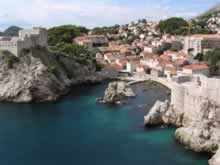Croatia
Croatia is that lovely stretch of land at the foothill end of
the Alps and bordered by sea by the Adriatic. By land, Croatia's
neighbours are Hungary, Slovenia, Serbia and Montenegro and Bosnia
and Herzegovina. Most recently a section of former Yugoslavia,
Croatia is a new nation, but its people have a long and tumultuous
history. Travelling to Croatia these days means finding an
enthusiastic culture full of national pride and a landscape that is
stunning and full of wonder.

Dubrovnik view
From mountain climbing to island hopping, visitors to Croatia
have a wealth of choices when it comes to experiencing the country.
Croatia has a vast expanse of national parks in order to protect
the natural beauty of its landscape. Some of these tracks include
islands and lake districts. Lonjsko Nature Park contains the
Posavac horse, a protected breed unique to Croatia.
The area of present Croatia has an ancient past that dates back
to the Stone Age. Neanderthal bones were discovered in Krapina Cave
that stretch back some 100,000 years. As early as 580 B.C. the
ancient Greeks installed colonies along the Dalmatian coast, but
further inland the Celts were the most powerful tribe in the area.
Eventually the area came under Roman control and still later,
Slavic tribes gained a foothold in 600 A.D. The exact origins of
Croatian peoples is widely disputed, but many historians believe
that are descended from Slavic tribes moving down from Poland and
mingling with a Slavic tribe in the area of today's Czech
Republic.

Capital: Zagreb
Languages: Croatian
Time: GMT +1 hr
Currency: kuna (HRK)
In any case, today's Croatians are proud of their new nation
that is not quite fifteen years old and eager to share the beauty
of their environment with visitors from around the globe.
Travellers will certainly want to pay a visit to some of the
national parks - there are many renowned resorts for pleasant stays
in these areas. The Dalmatian coast sees, as do the coastal cities
of Split and Dubrovnik, a walled city with medieval roots. Zagreb,
the capital has many attractions as well.

Plitvice Lakes National Park
When forming a travel itinerary, be sure to include the
following: Plitvice Lakes, Krk Island, Emperor Diocletian's Palace
(Split), Velebit Alps, Risnjak National Park, the Maritime Museum
(Split), Museum of Croatian Archaeological Monuments (Split),
Prince's Palace (Dubrovnik), National Assembly Building (Zagreb),
Rijeka Harbour, St. Stephen's Cathedral (Split), Croatian National
Theatre (Zagreb) and Old Town Alley (Split). Of course, Croatia's
entire Adriatic coast and its islands are tastes of paradise. The
clear blue water boasts an ancient appeal that draws visitors from
all walks of life. It is a nation of great inspiration and
beauty.
 Croatia Truffle Festival
Croatia Truffle Festival Sail Croatia - Dubrovnik to Trogir
Sail Croatia - Dubrovnik to Trogir Croatia Truffle Festival
Croatia Truffle Festival Sail Croatia - Dubrovnik to Trogir
Sail Croatia - Dubrovnik to Trogir